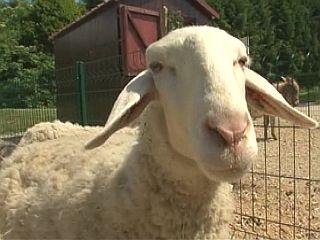
Slovenia's Solčava Valley, under the Savinja Alps, is known for its unspoiled beauty. However, one of the most unique aspects of this area is found in its meadows: an indigenous breed of sheep known as the Jezersko-Solčava breed.
One of just four breeds of sheep indigenous to Slovenia, the Jezersko-Solčava variety emerged when local Alpine sheep were bred with Begramesco and Padovana varieties from Italy. The resulting sheep became known for their large size, their convex heads, and the high quality of their wool. They were named for the Solčava Valley and the mountain village of Jezersko, where they were also common.
The new breed was perfectly suited to the cold, mountainous terrain of the area. Their long legs allowed them to master even the most precipitous meadows with ease, while their undemanding nature made them ideal for the Alpine climate where the grass-growing season tends to be brief.
Each Jezersko-Solčava sheep produces some two kilograms of wool per year, a large output that enabled local farmers living on remote homesteads to produce a wide variety of wool products for their daily needs. The high fertility of the sheep was another advantage that made it highly desirable even outside its ancestral home. Jezersko-Solčava sheep won major awards at international exhibitions as early as in the 19th century.
Events after World War II almost changed the breed forever. The authorities wanted the local farmers to crossbreed the sheep with the Merino variety in order to increase their output even further. The resulting sheep proved to be ill-suited to the cold Alpine environment, however, and the farmers eventually refused to take part in the project. The plan was abandoned, and the Jezersko-Solčava breed remained intact.
In recent years, the breed gained a new prominence as a regional symbol. The sheep, some of them with distinctive dark patches around their eyes, which give them the appearance of wearing glasses, can be seen in a growing number of meadows in the area. Slovenian sheep farmers have even joined up with their counterparts across the border in Austria, where the breed can also be found, to establish a common breeding program and a gene bank.
Slovenia is still the home of most Jezersko-Solčava sheep, however, and they are increasingly being used to promote the region's tourism. Their exceptionally flavorful meat is served in a growing number of local restaurants, while tourist farms are eager to show various aspects of sheep farming to their urban visitors. Some even allow city dwellers to participate in the shearing of sheep.
Many generations after the first Jezersko-Solčava sheep appeared in the valley’s meadows, the indigenous breed remains an important part of the region's cultural identity – and a symbol of its future as an important tourist destination.

































































